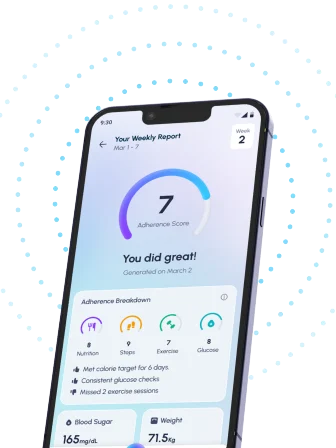Table of Contents
- Megan’s Journey: Living with Diabetes and POTS
- Understanding POTS and Diabetes: Megan’s Experience
- Diabetes, POTS, and Daily Life: A Guide from Megan
- Coping with Diabetes and POTS: Strategies from Megan’s Story
- Inspired by Megan: Navigating Diabetes and POTS Together
- Frequently Asked Questions
- References
Living with two chronic illnesses can feel like navigating a constant uphill battle, but what happens when those illnesses are as complex as diabetes and Postural Orthostatic Tachycardia Syndrome (POTS)? This blog post shares the inspiring story of Megan, a woman who’s not only bravely facing the challenges of living with diabetes and POTS, but also thriving despite them. Her journey is a testament to resilience, offering valuable insights and practical advice for anyone facing similar health hurdles. Prepare to be moved by Megan’s strength and learn from her experiences managing these intertwined conditions. Get ready to be inspired!
Megan’s Journey: Living with Diabetes and POTS
Navigating Two Complex Conditions
Living with diabetes and Postural Orthostatic Tachycardia Syndrome (POTS) presents unique challenges, especially in hot and humid climates prevalent across many Indian and tropical countries. The added strain of heat on the cardiovascular system can exacerbate POTS symptoms, making managing blood sugar levels even more critical. It’s crucial to remember that 50% of diabetes cases worldwide remain undiagnosed, highlighting the urgent need for increased awareness and proactive healthcare. Megan’s story underscores this reality.
Megan’s Experience: A Case Study
Megan, a resident of Mumbai, initially struggled with unexplained fatigue, dizziness, and rapid heart rate, especially upon standing. These symptoms, common in POTS, were initially misattributed to other causes. Later, she was diagnosed with both type 1 diabetes and POTS. Managing both conditions required significant lifestyle adjustments, including careful hydration, frequent small meals, and a focus on managing blood sugar levels, particularly during hotter months. The heat often amplified her POTS symptoms, leading to further complications. As she aged, she found that managing diabetes became even more challenging, requiring a more proactive approach to her healthcare.
Practical Tips for Managing Diabetes and POTS in Tropical Climates
Staying hydrated is paramount. Dehydration worsens both diabetes and POTS. Consuming electrolyte drinks can help replenish lost salts. Regular blood sugar monitoring is crucial, especially during periods of intense heat. Seeking medical guidance is essential, as managing these conditions requires a holistic approach tailored to the individual and their environment. Finally, connecting with support groups can offer invaluable emotional and practical support. Planning trips can also be tricky. Check out this helpful resource on traveling with diabetes for essential tips.
Finding Support and Resources
It’s important to remember you’re not alone. Numerous resources are available for people living with diabetes and POTS in India and tropical countries. Connecting with local diabetes and POTS support groups, or seeking advice from experienced healthcare professionals specializing in these conditions is crucial. Taking proactive steps towards managing these conditions can lead to a significantly improved quality of life.
Understanding POTS and Diabetes: Megan’s Experience
The Double Challenge
Living with diabetes presents significant challenges, especially in many Indian and tropical countries where access to healthcare and resources can be limited. The World Diabetes Atlas highlights that over 75% of people with diabetes reside in low- and middle-income countries, underscoring the global disparity in care. Adding Postural Orthostatic Tachycardia Syndrome (POTS) to this mix creates a double burden, impacting daily life in profound ways. Megan’s story exemplifies the complexities faced by many.
Megan’s Journey: Navigating POTS and Diabetes
Megan, a young woman from a rural area in India, experienced debilitating fatigue and lightheadedness, symptoms often associated with POTS. These symptoms were further exacerbated by her existing type 1 diabetes, making even simple tasks challenging. Managing blood sugar levels became even more difficult due to the fluctuating blood pressure associated with POTS. This required meticulous attention to her diet and medication regime, something particularly challenging given limited access to specialized healthcare in her region. She learned to adapt, however, developing strategies to manage both conditions effectively.
Coping Strategies and Support
Megan’s story highlights the importance of community support and access to reliable information. She found strength in online support groups, connecting with others facing similar challenges. This shared experience, coupled with consistent communication with her doctor, helped her develop a personalized management plan. Simple adjustments like increasing salt intake, staying hydrated, and using compression stockings became crucial to managing her POTS symptoms, which in turn improved her ability to manage her diabetes. Understanding the link between diabetes and other conditions, such as peripheral artery disease (PAD), is also crucial. For more information on how diabetes can contribute to PAD, you can read our article on How Does Diabetes Cause PAD?
Empowering Others in India and Tropical Countries
Megan’s resilience serves as inspiration for others in India and other tropical regions facing similar health challenges. Seeking support from healthcare professionals and connecting with online communities can significantly improve quality of life. While resources may be limited, proactive management, coupled with community support, can empower individuals to live fulfilling lives despite the challenges posed by diabetes and POTS. For those interested in learning more about managing other hormonal imbalances alongside diabetes, Managing PCOS with a Balanced Diet offers valuable insights.
Diabetes, POTS, and Daily Life: A Guide from Megan
Living with both diabetes and Postural Orthostatic Tachycardia Syndrome (POTS) presents unique challenges, especially in hot and humid climates prevalent across many Indian and tropical countries. The global burden of diabetes is staggering, with projections showing a rise from 536.6 million people (aged 20-79) in 2021 to a projected 783.7 million by 2045. This increase, coupled with the often-overlooked POTS, highlights the urgent need for better understanding and management strategies in these regions.
Understanding the Combined Challenges
Megan’s experience offers valuable insights. The heat and humidity common in tropical climates can exacerbate both conditions. For instance, dehydration, a significant concern for individuals with diabetes, worsens POTS symptoms like dizziness and fainting. Fluctuations in blood sugar levels are also amplified by the physical demands of managing POTS, requiring meticulous monitoring and adjustments in medication or dietary plans. Regular blood sugar checks and hydration are crucial, especially during the hottest parts of the day.
Megan’s Strategies for Managing Both Conditions
Megan emphasizes the importance of personalized strategies. She found that incorporating regular, low-impact exercise, tailored to her energy levels, improved both her diabetes management and POTS symptoms. Prioritizing rest and avoiding extreme temperatures are key. Moreover, she stresses the importance of a well-balanced diet, rich in fruits and vegetables, to stabilize blood sugar and maintain hydration. This is particularly vital in regions where access to nutritious food might be limited. For more tips on effective diabetes management, check out this helpful guide: 10 Proven Tips to Effectively Manage Diabetes | Simple Guide.
Actionable Steps for Indian and Tropical Climates
Individuals living with diabetes and POTS in Indian and tropical countries should consult their healthcare providers to develop a personalized management plan. This plan should account for the region-specific challenges, including heat, humidity, and potential accessibility issues. Remember to stay informed, prioritize your health, and seek support from healthcare professionals and support groups. If you’re a parent of a child with Type 1 diabetes, you might find this resource particularly helpful: Tips for Parents of Kids with Type 1 Diabetes: Complete Guide.
Coping with Diabetes and POTS: Strategies from Megan’s Story
Megan’s journey highlights the challenges of managing both diabetes and Postural Orthostatic Tachycardia Syndrome (POTS), particularly common in tropical climates like India. Her story underscores the importance of proactive management, especially given that up to 80% of Type 2 diabetes cases can be delayed or prevented through lifestyle changes. This emphasizes the crucial role of preventative healthcare, which is even more significant in resource-constrained settings common across many tropical regions.
Understanding the Interplay
POTS, characterized by a sudden increase in heart rate upon standing, often exacerbates diabetes management. The fluctuating blood sugar levels can worsen POTS symptoms, creating a vicious cycle. Megan found that careful hydration, a cornerstone of POTS management, also directly benefited her blood sugar control. Regular, smaller meals were vital for stabilizing both her blood sugar and blood pressure, avoiding the drastic fluctuations that triggered POTS episodes.
Megan’s Actionable Strategies
Megan’s success stems from a holistic approach. She prioritized regular exercise, focusing on low-impact activities like yoga and walking, crucial for managing both conditions. She also emphasized the importance of stress management through meditation and mindfulness techniques, vital in managing the often-overwhelming symptoms of both illnesses. Dietary modifications, including increased fiber intake and reduced processed foods, were essential in controlling her blood sugar levels and preventing POTS flare-ups. These lifestyle adjustments, achievable even in resource-limited areas, showcase the power of personalized management. For more specific tips, check out our guide on 10 Proven Tips for Effective Diabetes Management.
Empowering Communities in India and Beyond
Megan’s experience provides a powerful message for individuals across India and other tropical countries: proactive lifestyle changes are key to managing chronic conditions effectively. Seeking support from healthcare professionals and joining support groups can significantly improve quality of life. By understanding and adapting these strategies, individuals can take control of their health and live fulfilling lives despite the challenges of managing diabetes and POTS. Learn more about preventative healthcare strategies. Making even 5 Easy Lifestyle Changes to Manage Type 2 Diabetes can make a significant difference.
Inspired by Megan: Navigating Diabetes and POTS Together
The global rise in diabetes is alarming, with the number of people affected increasing from 200 million in 1990 to a staggering 830 million in 2022, according to the World Health Organization (WHO). This stark reality highlights the urgent need for better understanding and management of the condition, particularly in regions like India and other tropical countries where diabetes prevalence is significantly high. Adding another layer of complexity is the coexistence of diabetes with Postural Orthostatic Tachycardia Syndrome (POTS), as experienced by Megan.
Understanding the Challenges: Diabetes and POTS in Tropical Climates
Living with diabetes presents unique challenges in hot and humid climates. Dehydration, a common concern in tropical countries, can worsen both diabetes and POTS symptoms. Fluctuations in blood sugar levels can be amplified by heat, leading to increased fatigue, dizziness, and fainting – all common POTS symptoms. Managing these conditions requires careful attention to hydration, dietary choices, and medication adherence, particularly vital for individuals living in these specific regions. Megan’s story serves as a powerful reminder of the importance of personalized care and proactive strategies. For more information on creating a personalized diabetes management plan, check out Personalized Diabetes Control: Your Key to Better Health.
Megan’s Journey: A Source of Hope and Inspiration
Megan’s experience showcases the possibility of thriving despite the combined challenges of diabetes and POTS. Her journey highlights the importance of strong support networks, both medical and personal. Learning to listen to your body, adapting your lifestyle to your individual needs, and consistently monitoring your health are key takeaways from Megan’s experience. This proactive approach is especially crucial in resource-constrained healthcare settings, prevalent in some parts of India and other tropical nations.
Finding Support and Moving Forward
Megan’s story inspires us to seek out community and support. Connecting with others who understand the complexities of managing both diabetes and POTS is invaluable. Sharing experiences and strategies can empower individuals to navigate their challenges effectively. In India and other tropical regions, finding local support groups or online communities can be a significant step towards better management and improved quality of life. Remember, you are not alone, and resources are available to help you thrive. For those looking to manage their weight alongside diabetes, How to Gain Weight with Diabetes Safely and Effectively – Tap Health offers valuable guidance.
Frequently Asked Questions on Living with Diabetes and POTS
Q1. What are the biggest challenges of managing Type 1 Diabetes and POTS together, especially in hot climates?
Managing Type 1 Diabetes and POTS concurrently presents significant challenges, particularly in hot and humid environments. Dehydration worsens both conditions, while fluctuating blood sugar levels can intensify POTS symptoms. The heat itself adds another layer of difficulty.
Q2. What is a holistic approach to managing both Type 1 Diabetes and POTS?
A successful management strategy involves a holistic approach encompassing meticulous hydration, frequent small meals to stabilize blood sugar, regular blood sugar monitoring, and a tailored exercise plan. Community support and a personalized healthcare plan are also vital.
Q3. How crucial is access to healthcare and resources in managing these conditions?
Access to quality healthcare and resources is crucial for effective management. However, even with limitations, proactive self-management strategies can significantly improve quality of life.
Q4. What role does proactive management play in improving quality of life with Type 1 Diabetes and POTS?
Proactive strategies, including careful hydration, dietary management, and regular monitoring, are key to improving quality of life. Community support and personalized plans further enhance outcomes, even with limitations in healthcare access.
Q5. Why is increased awareness of Type 1 Diabetes so important?
The high global prevalence of undiagnosed diabetes highlights the urgent need for increased awareness and preventative healthcare. Early diagnosis and proactive management are critical for improving health outcomes and quality of life.
References
- A Practical Guide to Integrated Type 2 Diabetes Care: https://www.hse.ie/eng/services/list/2/primarycare/east-coast-diabetes-service/management-of-type-2-diabetes/diabetes-and-pregnancy/icgp-guide-to-integrated-type-2.pdf
- Diabetes Mellitus: Understanding the Disease, Its Diagnosis, and Management Strategies in Present Scenario: https://www.ajol.info/index.php/ajbr/article/view/283152/266731




